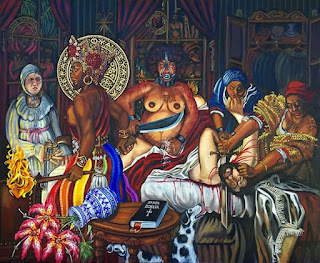I'm in awe of Lili Bernard
I'm in awe of Lili Bernard, whose "Antebellum Appropriations" paintings are a tour-de-force that reinterpret Black women's history in the Americas by reworking classic European paintings. "Carlota Slaying the Slaver (after Artemisia Gentileschi’s Judith Slaying Holofernes, 1612), Bernard has a naked, shackled woman take a knife to her slaveholder’s genitals while two other women thrust a sword into his neck and another woman holds a white witness at bay."
There is so much going on in this painting. Carlota Lucumí, trafficked to Cuba as a child, was one of the leaders of a revolt against slavery in the brutal sugar mills in Matanzas, Cuba (1843). Her chest is branded, and so is that of Anastasia Escrava, a legendary Brazilian saint who is usually depicted wearing a slavery bridle.
As she is here, while castrating her rapist, which is how i read her pregnancy in this picture.
The frowning white mistress of the house is held at bay by a breasted and bearded Oya carrying a sword and torch, whose identity is shown in her halo, her red regalia, and her skirt of nine colors (attribute of her Yansa aspect, as "Mother of the Nine"). Gazing in through a window is Nana Burukú, the Grandmother, with many children in her embrace. The other window shows a lynching of a woman in the distance.
"Trauma is central to Bernard's work. The Los Angeles-based artist, who was born in Cuba and was raised primarily in New Jersey, delves into trauma experienced by African people brought to the New World as slaves and the scars that exist many generations later. She explores traumas experienced by women, whether it's the struggle to attain a beauty ideal to the pain of sexual assault. Bernard's work is boldly feminist and as universal in its themes as it is personal.
"In remaining famed works, Bernard comments on what's missing in art history. "They're very beautiful, very serene, but what's omitted from that narrative is the institution that sustained that life, which is slavery," she says.
"Even if they were in Europe, the Kings and Queens were still being sustained by the slavery that was going on in the New World." She continues," I thought that by appropriating these European paintings into slave stories, I was kind of owning the story and positioning myself, or positioning the story of my ancestors into the halls of art history."




Comments
Post a Comment